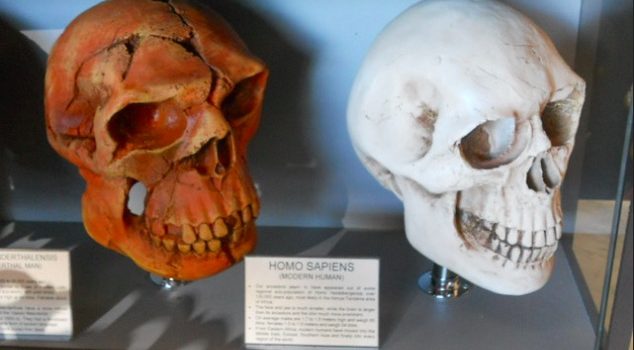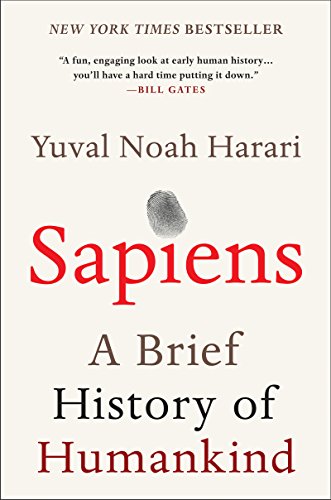

This article is an excerpt from the Shortform summary of "Sapiens: A Brief History of Humankind" by Yuval Noah Harari. Shortform has the world's best summaries of books you should be reading.
Like this article? Sign up for a free trial here .
What were our ancestors the early Homo sapiens like? How did they live? How did they communicate? What did they eat? How did they shape our lives today?
We don’t know much about the early Homo sapiens, but we do know that they were cooperative, nomadic, and extremely knowledgeable. Early Homo sapiens may be the most knowledgeable humans in the history of mankind.
We’ll cover how early Homo sapiens lived and how they came to dominate other animals.
The Characteristics of Early Homo Sapiens
Early Homo sapiens shared characteristics with other human species. Of the eight known human species, only one survived. Before we discuss how early Homo sapiens became the dominant humans, let’s look at what all the human species had in common.
Characteristic #1: Large Brains
Mammals that are 130 lbs typically have a brain that’s an average of 12 cubic inches. In contrast, the brains of early humans were 36 cubic inches. Today, our average brain size is 73-85 cubic inches, and the brains of Neanderthals were even bigger than ours.
It seems like large brains would give us and our fellow humans an obvious advantage over other animals, but it wasn’t necessarily an asset to early humans.
The Disadvantages of a Big Brain
Big brains take a lot of energy to fuel. Our brains make up 2-3% of our body weight, but use 25% of our energy. (The brains of our ape siblings only use 8% of their energy.)
This drain of energy caused two main problems:
- Problem #1: Humans had to spend a lot of time searching for food (they needed a lot of calories to feed their hungry brains).
- Problem #2: Their muscles atrophied because their bodies had to divert energy from muscles to feed the brain.
When you’re in the middle of the food chain, trying to catch small animals and keep out of the way of big ones, using your energy to power your brain instead of your muscles isn’t the smartest strategy.
We still don’t really know why we evolved such large brains when there was little use for them in early history. It was a bad use of our energy.
Characteristic #2: Walking Upright
All human species, including early Homo sapiens, walked upright. Like having a big brain, walking upright seems like an unequivocally positive trait to us today, in part because we still walk upright and can’t imagine moving any other way. There were both advantages and disadvantages to walking upright.
Pros:
- A better view: When you’re standing, it’s easier to see the lion hiding in the grass or the prey oblivious to you.
- The ability to use tools: When you don’t need your arms for moving around, they’re freed up for other tasks, like signaling to others and using tools. As we evolved more nerve endings and agile muscles in our hands, our tools became more sophisticated.
Cons:
- An unstable skeleton: Because we’re built to walk on all fours like most mammals, our skeletal structure doesn’t easily support our large heads. Consequently, we get back and neck aches.
- Narrow hips: To walk upright, women (and men) evolved narrower hips, but this was bad news for childbirth. As women’s hips were getting narrower, babies’ heads were getting bigger.
Narrow hips especially had far-reaching consequences for early Homo sapiens, creating a domino effect that led to helpless babies. This was because the women who survived the dangerous activity of childbirth (and continued to pass on their genes through subsequent births) were the ones who gave birth early in the fetus’s gestation, when the baby’s head was smaller and undeveloped.
Consequently, women evolved to give birth earlier when the fetus is less developed. This means that human infants are undeveloped and helpless compared with other animal infants. For instance, a colt can start to run soon after birth, and a kitten finds food on its own after a few weeks. But human children are dependent on their parents for years.
The fact that human children were vulnerable for years after birth meant that human adults had to care for and protect them for years. Like having a big brain, this wasn’t an obvious advantage for early humans. They needed their energy for activities like escaping the jaws of larger, stronger animals.
The Consequences of Having Premature Babies
Despite the risks involved in caring for vulnerable infants, their existence created unique social situations for humans. These situations and the resulting societal bonds may have contributed to the rise of human dominance in the animal kingdom.
There were two unique results of human children of early Homo sapiens being born prematurely:
Result #1: The “It Takes a Village” Mentality: Because children were so helpless, mothers relied on family members and neighbors to raise them. Many other animal genera (plural of “genus”) didn’t have the need to form these social bonds.
Result #2: The Potential for Socialization: Children born relatively helpless are (relative) blank slates. As such, their societies can shape them through education and socialization to be whatever they want them to be. Whereas other mammals are born like glazed earthenware coming out of the kiln (if you try to reshape them, they’ll break), humans are born like molten glass, easily formed and reformed.
Fire and Early Homo Sapiens
The domestication of fire changed the game, giving early Homo sapiens power over the natural world that no other animal possessed. Fire was a source of light. It was warmth in the cold months and a weapon in moments of conflict. You could even use fire to burn through impassable underbrush, changing the landscape to fit your needs.
The most important use of fire was cooking. Cooking food made it easier to digest. Since digestion was easier, the long intestine became shorter. This development was especially important. Big brains and big intestines both use a lot of energy. By allowing humans to better digest food and evolve shortened intestines, fire may have indirectly contributed to the brain getting a greater share of the body’s energy. As the brain got more energy, it got bigger.
When early Homo sapiens mastered fire, they finally gained a key to developing dominance over animals that were stronger and faster than they were.
Early Homo Sapiens: The Life of a Forager
We’ve only been working in offices and, before that, as farmers and herders, for the last 12,000 years. For hundreds of thousands of years before that, the majority of our species’ history, we were foragers.
We Don’t Know Much About Foragers
Because foragers moved every week, sometimes every day, they had few personal possessions. They only had what they could carry themselves, without the aid of wagons or pack animals. Consequently, early Homo sapiens during the period between the Cognitive Revolution and the Agricultural Revolution left few artifacts. Dependence on the few artifacts discovered creates an incomplete and even misleading picture of our ancestors.
It’s also hard to talk about how early Homo sapiens lived because there was no single way of life (as there isn’t now). Still, attempting to piece together how our ancestors lived from 70,000 to 12,000 years ago can give us insight into our modern society.
The Few Things We’re Pretty Sure Of
- There weren’t many humans. The whole human population was smaller than the number of people living in Cairo today.
- Early Homo sapiens lived in bands of up to several hundred individuals.
- Neighboring bands cooperated, but also fought. Each band was likely independent. They traded with each other, but weren’t dependent on each other for essentials like fruit and meat. They traded “prestige items” like shells and pigments.
- There were no permanent homes, towns, or governments. Early Homo sapiens roamed back and forth across their territory, according to animal migrations and changes in the seasons. Fishing villages might be an exception.
- They ate broadly: termites, berries, roots, rabbits, bison, and mammoth, among other foods.
- They had knowledge: There was little specialization of skills. Everyone needed to know how to make a knife, mend clothing, trap prey, escape lions, and heal snakebites. Early Homo sapiens in the forager period were some of the most skilled and informed people in history.
Early Homo Sapiens Had a Good Life
Foragers had many advantages over their descendants.
Short Working Hours
Westerners spend an average of 40-45 hours working a week (and some people in developing countries work up to 80 hours a week). Even modern foragers, who generally live in inhospitable environments, hunt and gather for 35-45 hours a week.
It’s very possible that early Homo sapiens spent much less time working to find food and resources. Many of them lived in lands much more fertile than the Kalahari Desert. They also didn’t have the chores that take up our time today, like vacuuming, paying bills, and washing dishes.
Health
There were a couple of reasons early Homo sapiens were taller and healthier than Sapiens after the Agricultural Revolution.
Varied Diet
Because early Homo sapiens might eat berries, snails, and rabbit one day and mushrooms, fruits, and mammoth the next, they were rarely malnourished. They got all the nutrition they needed from the variety in their diets.
Farmers, and the societies that depend on them, tend to rely on calories from a single crop, like wheat or rice. Relying on one food means you’re not getting the variety of nutrients you need to be healthy.
Less Disease
Many diseases afflicting early Homo sapiens’s descendants came from domesticated animals. Because their only domesticated animal was the dog, there was less opportunity for the spread of disease.
Additionally, forager populations were spread thinly across the land. Epidemics were uncommon. Later societies would live in close quarters and unhygienic environments, fueling the spread of dangerous epidemics.
Early Homo Sapiens Had Their Own Problems
Although early Homo sapiens had many advantages over later Sapiens, we shouldn’t idealize their societies. Foragers dealt with issues that have decreased over time.
For instance, child mortality was high for early Homo sapiens. Interactions with wild animals often resulted in death. People who slowed down the group, including the elderly, disabled, and children, may have been killed.
Our ancestors were neither wholly good nor wholly bad. Just like us, they were human, doing their best to survive in sometimes difficult circumstances.
The Things We Can’t Know
There are gaps in our knowledge about early Homo sapiens that probably won’t ever be filled.
Was There Religion?
Yes, but we can’t know much about our ancestors’ fictions. We can make guesses about their beliefs, but those guesses often say more about our modern biases than about what foragers thought and felt.
Animism
Most experts agree that early Homo sapiens were animists rather than theists.
- Animism: The belief that every animate and inanimate thing has thoughts and feelings and can communicate with people. This belief system is non-hierarchical—all beings are equal.
- Theism: The belief in a god or gods that are above us in status and create the universal order of our world. This belief system is hierarchical—divine beings outrank non-divine beings.
Our forager ancestors probably believed that all animate things (mice, deer, and spirits) and inanimate things (rocks, rivers, and trees) had feelings and desires. They also had the capability to reward or punish early Homo sapiens for their actions.
Because animism is non-hierarchical, there were no walls separating people from the rest of the natural world. People were not of a higher status than other animals, plants, spirits, and inanimate objects. Early Homo sapiens didn’t believe that spirits, trees, and animals existed to serve or please them.
Animism doesn’t refer to a particular religion. Within this general concept, there were probably many religions practiced and beliefs believed by foragers.
Evidence of Early Fictions
Although we don’t know what early Homo sapiens believed, we do know that they had fictions.
For example, in Russia, archeologists discovered burial site containing numerous graves. Most of the graves were unnotable, but one contained the skeletons of two children, a boy and a girl. The children were adorned with thousands of ivory beads and fox teeth and were surrounded by statuettes and other ivory objects.
Carving the beads alone would have involved 7,500 hours of work. It was clear that there was something special about these kids. But these kids were too young to have achieved prominence in their band by being great leaders or hunters.
We don’t know why they were special, but it’s clear that this band held some kind of imaginary reality that gave the children status beyond their DNA or their ability to help the band survive and procreate.
Even though we’ll never know what our ancestors believed, what their social structures looked like, or what political strife occurred, it’s crucial that we speculate. If we don’t ask how foragers shaped our current world, we might assume that they didn’t. But, as we’ll see in the next chapter, Sapiens after the Cognitive Revolution reshaped the natural and social worlds around them, legacies we still grapple with today.
———End of Preview———

Like what you just read? Read the rest of the world's best summary of "Sapiens" at Shortform . Learn the book's critical concepts in 20 minutes or less .
Here's what you'll find in our full Sapiens summary :
- How Sapiens outlived and outlasted the 8+ other human-like species on Earth
- The 3 critical revolutions in human existence that led to our domination of the planet
- How much of what powers our world today is really just a shared mass delusion
- What the future of humanity might look like





